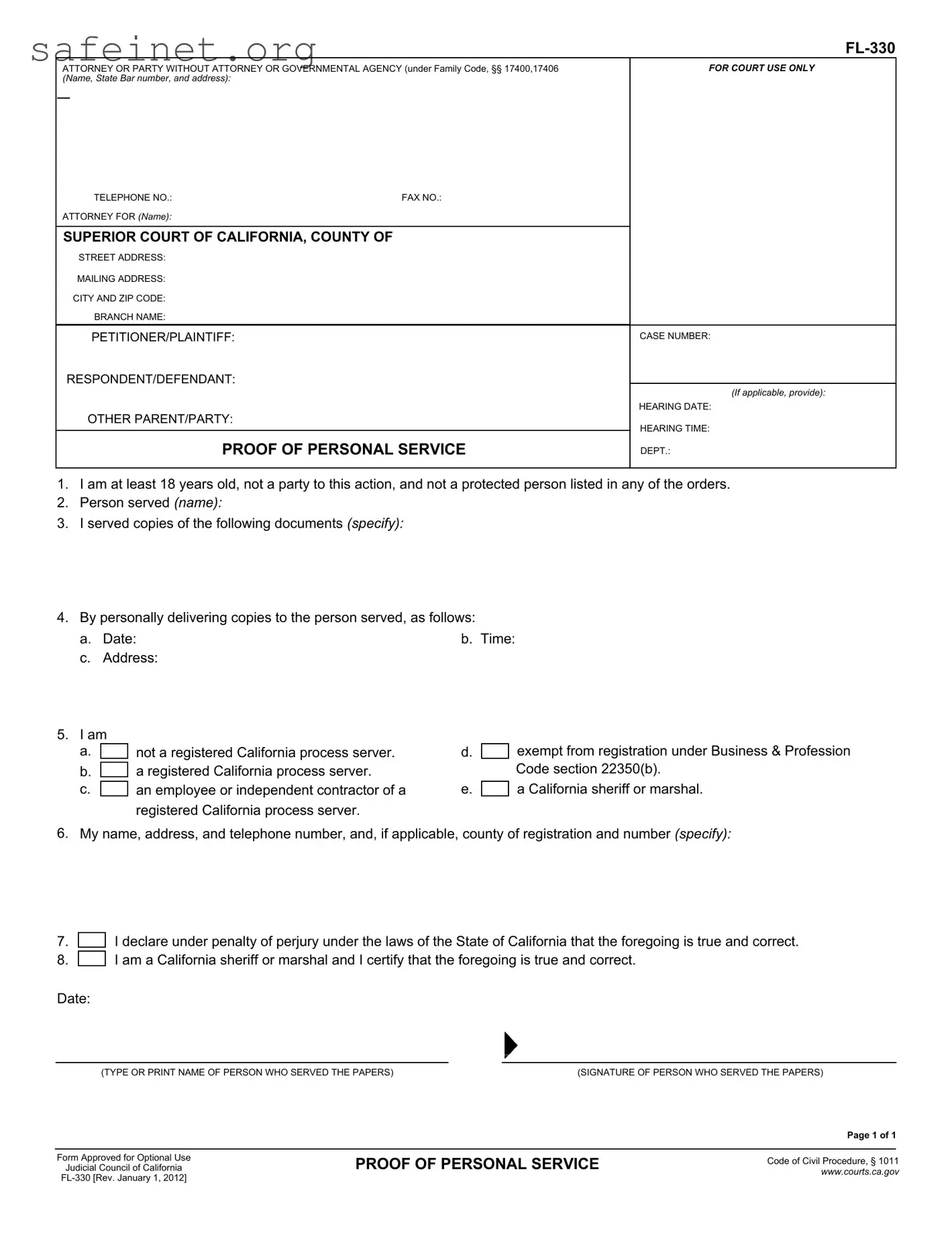The FL-330 form, used primarily for proving personal service in family law cases, shares similarities with the FL-335 form, which is the Proof of Service by Mail. Like the FL-330, the FL-335 documents the process of serving legal papers to involved parties, ensuring all necessary information about the service process is recorded. However, while the FL-330 requires proof of personal delivery, the FL-335 outlines the method of serving documents via postal mail, specifying the dates and addresses involved in the mailing process. Both forms ensure proper documentation and accountability in serving legal documents, but they cater to different methods of service.
The FL-310 form, which is used for a Request for Order, is another document that bears resemblance to the FL-330. Both forms are essential in family law proceedings when parties seek court intervention. The FL-310 formally requests actions from the court regarding various family law matters, whereas the FL-330 focuses specifically on confirming that legal documents have been personally delivered to the relevant parties. Each form plays a crucial role in guiding the court process, ensuring that all parties are informed and that procedures are properly followed.
The FL-300 form, known as the Declaration for Default or Uncontested Judgment, is also similar in function to the FL-330. Both forms are utilized within the family court system to uphold procedural integrity. The FL-300 uses a declaration to claim that no party is contesting any issues, allowing for a default judgment. In contrast, the FL-330 addresses how and when individuals have been served with necessary documents. Therefore, both documents facilitate the court's ability to manage cases effectively, although they focus on different stages of the legal process.
The FL-341 form, titled the Declaration Under Uniform Child Custody Jurisdiction and Enforcement Act, has notable similarities with the FL-330. Both forms assist in providing necessary information to the court, ensuring that all procedural requirements are met. The FL-341 specifically addresses custody jurisdiction matters, while the FL-330 verifies that parties have been served with relevant documents regarding their case. Each document's integrity supports the court’s decision-making process concerning family law cases.
The FL-340 form, known as the Notice of Motion, is another document akin to the FL-330. While the FL-330 verifies personal service, the FL-340 formalizes a request for a hearing and outlines the issues to be addressed. Both forms require thorough documentation and are crucial for ensuring that all parties are notified of changes or requests within the court proceedings. They together facilitate transparency and procedural compliance within the court system.
The FL-335 form, which serves as an alternative method for serving legal documents, is important to note. Both the FL-330 and the FL-335 focus on different means of delivering legal documents to involved parties. While the FL-330 confirms personal service, the FL-335 allows for service via postal mail. Each form serves its purpose in providing the court with proof regarding how documents were served, ensuring that all parties are made aware of legal proceedings without ambiguity.
The FL-341(C) form, a declaration of disclosure, shares a link with the FL-330 by requiring thorough documentation. The FL-341(C) ensures that all parties disclose relevant financial information for equitable decision-making. Similarly, the FL-330 serves to confirm that all parties are notified of necessary proceedings. Both forms exhibit the importance of transparency and communication in family law cases, assisting the court in making informed decisions based on complete information.
Finally, the FL-341(A) form, which is a declaration of adherence to the California Child Support Guidelines, resembles the FL-330 in its procedural significance. While the FL-341(A) emphasizes financial obligations, the FL-330 focuses solely on the process of serving documents. Both documents are vital in family court settings, as they ensure all parties are well-informed about their responsibilities and the court's expectations. Each form works collaboratively to uphold order and facilitate fair legal outcomes for families involved in court proceedings.

